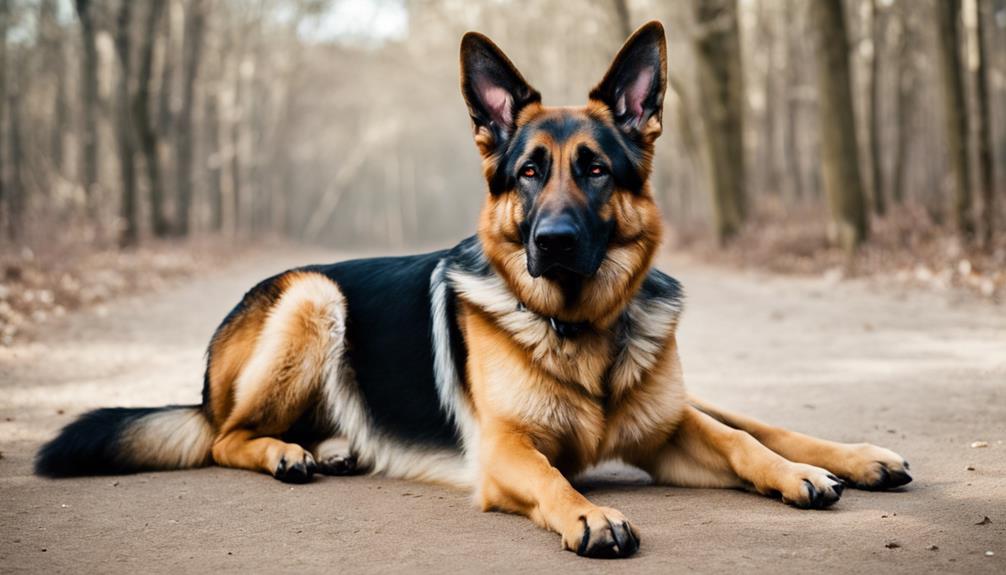When it comes to training your German Shepherd, think of Gary Hanrahan's tips as a guiding light in the vast world of canine behavior. Understanding the intricacies of your furry companion's actions can significantly impact your training journey.
By grasping the fundamentals of Hanrahan's approach, you'll be equipped to navigate the nuances of your German Shepherd's behavior successfully.
Stay tuned to uncover how establishing clear communication channels and implementing positive reinforcement techniques can transform your training sessions into fruitful experiences for both you and your loyal companion.
Understanding Your German Shepherd's Behavior

Understanding the behavior of your German Shepherd is crucial for effective training and building a strong bond with your loyal companion. German Shepherds are intelligent and loyal dogs, known for their protective nature and strong work ethic.
To effectively understand your German Shepherd's behavior, it's essential to pay close attention to their body language and behavioral cues. These cues can provide valuable insights into your dog's emotions and intentions. For example, a tucked tail or flattened ears may indicate fear or discomfort, while a wagging tail and perked ears often show excitement or alertness.
Socialization plays a vital role in shaping your German Shepherd's behavior. Exposing your dog to different environments, people, and animals from a young age can help prevent fear and aggression later in life. Consider enrolling your German Shepherd in playgroups or arranging playdates with other well-behaved dogs. These interactions can teach your dog proper social skills and help them feel more comfortable in various situations.
Establishing Clear Communication Channels
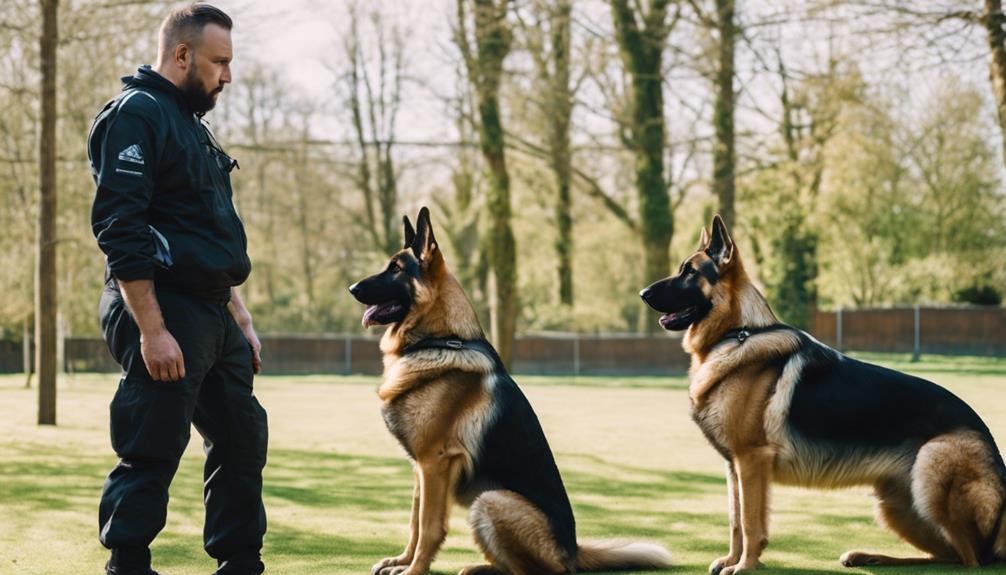
To effectively communicate with your German Shepherd, establish clear and consistent cues for commands. Dogs, especially German Shepherds, are highly responsive to body language signals and voice tone cues. When giving commands, use a firm tone of voice for more serious directives like 'sit' or 'stay,' and a softer, more encouraging tone for praise or playful interactions. Consistency in your cues is key to helping your German Shepherd understand what's expected of them.
When using body language signals, make sure they're deliberate and easily distinguishable. For example, when teaching your dog to sit, accompany the verbal command with a hand gesture where you raise your hand upward. This visual cue helps reinforce the command and aids in your German Shepherd's understanding.
Voice tone cues play a significant role in how your German Shepherd interprets your commands. A commanding tone communicates authority, while a gentle tone conveys praise and positivity. By consistently using specific tones for different commands, you help your dog differentiate between instructions.
Implementing Positive Reinforcement Techniques
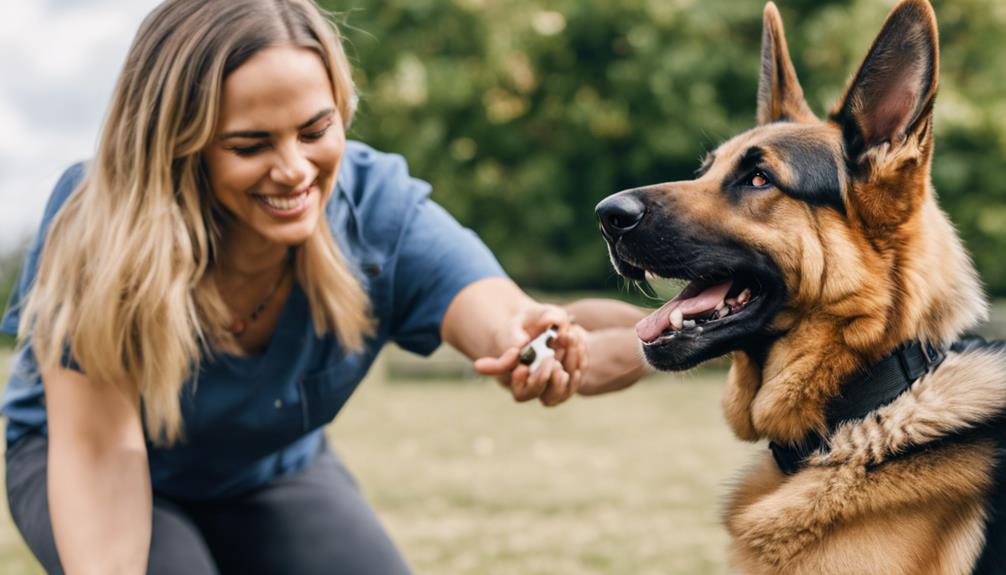
When implementing positive reinforcement techniques with your German Shepherd, consistently reward desired behaviors to encourage their repetition and strengthen the bond between you and your dog. Positive reinforcement is a powerful tool in dog training that focuses on rewarding the behaviors you want to see more of, rather than punishing unwanted behaviors. Here are some tips to effectively implement positive reinforcement techniques:
- Clicker training: Utilize a clicker to mark the precise moment your German Shepherd performs the desired behavior, followed by a treat reward. Clicker training helps your dog understand which actions lead to rewards, making learning more efficient and fun for both of you.
- Treat rewards: Use high-value treats such as small pieces of cooked chicken or cheese to reinforce good behaviors. These treats should be especially appealing to your German Shepherd and reserved solely for training sessions to maintain their value as rewards.
- Consistency is key: Be consistent in your timing and delivery of rewards. Your German Shepherd should associate the reward with the correct behavior, so make sure to praise and treat immediately after they perform the desired action.
Consistency Is Key in Training
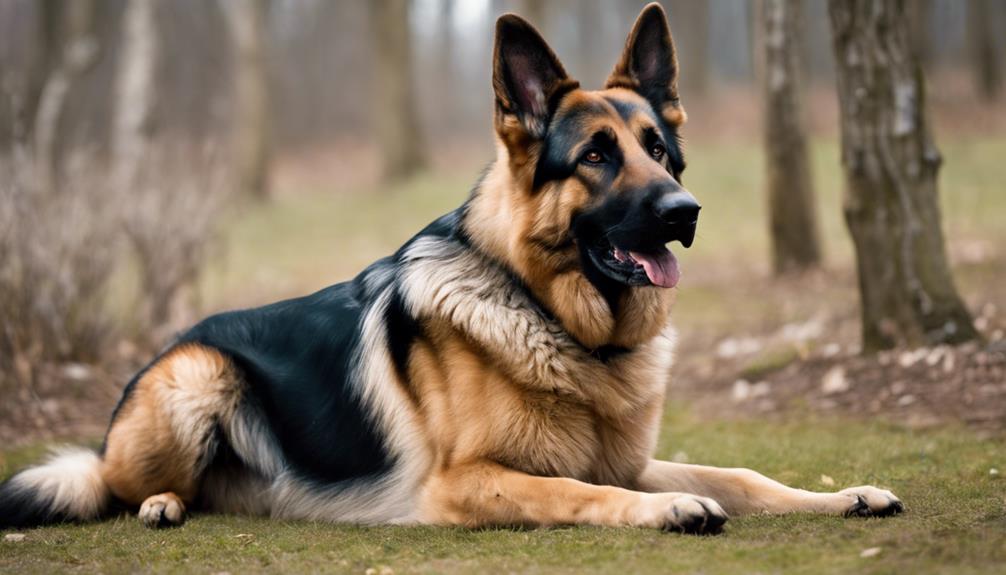
For effective training with your German Shepherd, maintaining consistency in your approach is crucial for reinforcing desired behaviors and building a strong training foundation. Building routines is essential in helping your German Shepherd understand what's expected of them. Consistency means using the same commands, gestures, and rewards each time you train. This predictability helps your dog learn faster and prevents confusion.
When you establish routines, your German Shepherd knows when it's time to train and what to expect during these sessions. Consistency in your training schedule sets clear boundaries and creates a structured environment that's conducive to learning. Dogs thrive on routine, so sticking to a consistent training schedule will help them focus and retain information better.
Reinforcing boundaries is another vital aspect of consistency in training. By consistently enforcing rules, such as not allowing your German Shepherd on the furniture or only feeding them at specific times, you establish a clear understanding of what behaviors are acceptable. Consistency in enforcing these boundaries helps prevent confusion and ensures that your German Shepherd knows the limits of acceptable behavior.
Building Trust Through Training
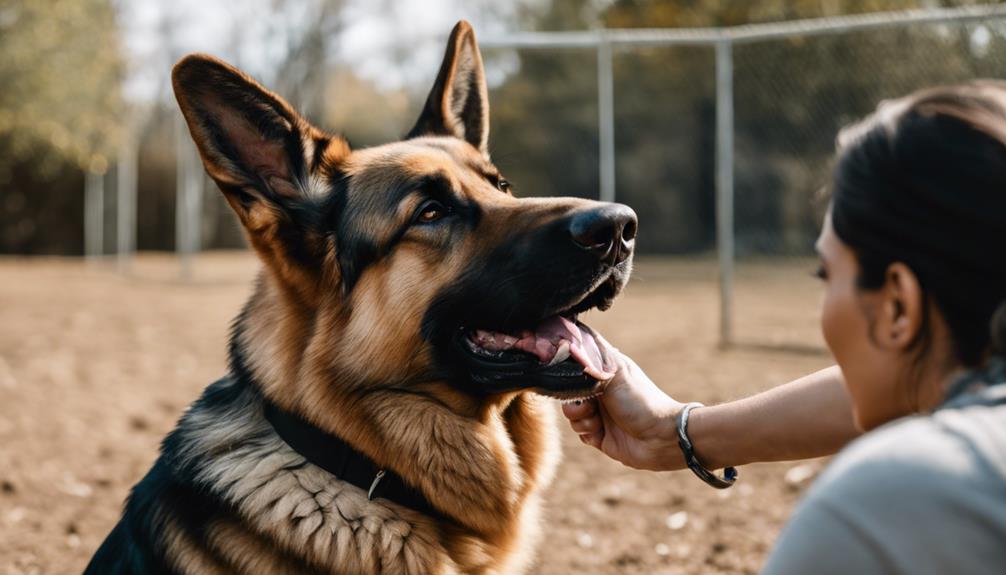
Establishing a strong bond through consistent training practices is essential for fostering trust between you and your German Shepherd. Building trust through training requires patience, understanding, and a deep connection with your canine companion. Here are some effective strategies to strengthen the bond and trust between you and your German Shepherd:
- Consistent Routine: Implementing a consistent training schedule helps your German Shepherd understand what's expected of them. Consistency in training builds predictability and reliability, which are essential for trust to develop.
- Positive Reinforcement: Using positive reinforcement techniques such as treats, praise, and playtime can help reinforce good behavior and strengthen the bond between you and your German Shepherd. Positive interactions create a positive association with training and build trust over time.
- Bonding Exercises: Engaging in activities that promote bonding, such as interactive play, grooming sessions, or going for walks together, can help deepen the connection between you and your German Shepherd. These activities create shared experiences and build trust through mutual enjoyment.
Frequently Asked Questions
How Can I Prevent My German Shepherd From Becoming Aggressive Towards Other Dogs or Strangers?
To prevent your German Shepherd from becoming aggressive towards other dogs or strangers, start early socialization and use positive reinforcement. Learn behavioral cues and body language to address issues promptly and effectively.
What Are Some Common Mistakes That Owners Make When Training Their German Shepherds?
When training your German Shepherd, common mistakes include inconsistent commands, lack of positive reinforcement, and improper socialization. Remember, behavior correction is key. Stay patient, be consistent, and always reinforce good behavior to build a strong bond.
Is It Possible to Train an Older German Shepherd, or Is It Better to Start Training When They Are a Puppy?
Training older dogs is possible with patience and consistent training methods. Address behavioral challenges using positive reinforcement and socialization techniques. While starting as puppies is ideal, older dogs can still learn and benefit from training.
How Can I Help My German Shepherd Overcome Separation Anxiety?
When helping your German Shepherd with separation anxiety, remember to be patient. Incorporate behavior modification techniques, training tools, and crate training. Consistency is key. Provide comfort, but also encourage independence. Gradually increase alone time.
Are There Specific Training Techniques That Are More Effective for German Shepherds Compared to Other Breeds?
When training your German Shepherd, focus on obedience training and socialization. Use positive reinforcement and consistency to help them learn effectively. German Shepherds respond well to these techniques, making training more successful.
Conclusion
Now that you have learned some valuable training tips for your German Shepherd, remember to be patient and consistent in your efforts.
Building a strong bond with your furry friend takes time and dedication. Can you imagine the joy of seeing your well-trained German Shepherd happily obeying your commands?
Keep practicing and soon you'll experience the rewards of a well-behaved and obedient companion. Happy training!
